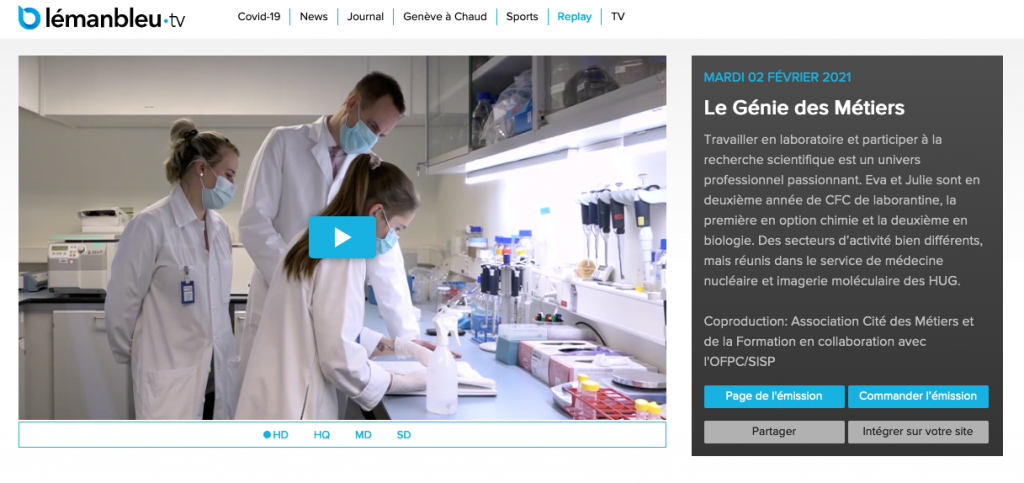Doing research at a leading institution like the CIBM Center for Biomedical Imaging while gaining practical experience and contributing to tangible results is a dream of many students. Now, thanks to projects like the Imageable Genome, young researchers’ contributions can begin early in their scientific education journey. Traineeship programs like that can be a stepping stone in young researchers’ professional, intellectual, and personal development. The mentors, Dr. Vincent Taelman (VT), the CIBM PET HUG-UNIGE Molecular Imaging Section research staff scientist, and Prof. Dr. Martin Walter (MW), the head of the section shed some light on the activities of the department and their daily work with the students.
1. Tell us more about the CIBM PET HUG-UNIGE section traineeship program.
VT: Our apprentices belong to a program organized by Association Genevoise pour les Métiers de Laboratoires (AGEMEL), at the end of which they will obtain the “certificat fédéral de capacité” (CFC). We decided to enroll apprentices last year as it seemed necessary for them to have more opportunities to acquire specific qualifications, such as biology and chemistry, and for the department to be more visible as the Nuclear Medicine field is mostly unknown to most of the public. At the moment, we have two apprentices, Eva in chemistry and Julie in biology. They are in their second year of a 3 years apprenticeship.
MW: We started to program to actively participate in training the next generation of laboratory personnel. This decision was not just altruistic – in order to provide our patients with the highest quality of care, we constantly depend on recruiting the best personnel for our laboratories, which is not easy. We hope that, with entering the training program, we will also be able to assure that we have the best candidates for joining our laboratories in the future.
2. As mentors, how do you ensure that the traineeship experience is engaging and productive?
VT: Our goal is to maximize the professional growth that occurs during the internship. From the very first days, we fully engage the students in their new work environment through active and consistent dialogue and collaboration. In addition to the work they do in our laboratory, our apprentices follow classes and have exams organized by AGEMEL on a regular basis, which allows us to follow their progression step by step.
MW: We also make sure that our apprentices are involved in fascinating and challenging projects. One project that Dr. Taelman is performing with the students uses molecular imaging to quantify CRISPR Cas activity. This technology won the Nobel Prize last year and learning such a relevant technique for the future is very stimulating.
3. What are the rewards of mentoring?
VT: The greatest reward of mentoring is knowing that we help future generations of researchers find employment that is both fulfilling for themself and essential for society.
MW: I share the enthusiasm for mentoring with Dr. Taelman. Seeing our young students constantly developing on a professional and personal level, and as team members is extremely satisfying.
4. Does CIBM’s strong commitment to early career researchers have anything to do with your own experiences? Have you had influential mentors at the start of your careers?
VT: All my mentors had an important influence on my career, but I have been interested in biology since I was a child. At CIBM, we believe that all young researchers should have positive traineeship experiences that’s why this program is of great importance to us.
MW: I only became a nuclear medicine physician because of my mentors. More or less by accident, I trained with key founders of modern nuclear medicine, including the inventors of positron emission tomography and radiopeptide therapy, and I stayed in the field because I loved working with them.
5. Looking back at your own research journeys, what advice would you give to the young generation of scientists?
VT: The only advice I would give to the young generation of scientists is to believe in themselves and their ideas and just go for it.
MW: Stay curious and don’t lose your willingness to learn.
About Genome Imaging
The Imageable Genome project of the CIBM PET HUG-UNIGE Section strives to improve the accessibility of the human genome by facilitating non-invasive characterization of gene expression data in the whole body by PET imaging. The overarching aim of this project is to gain insight into the dynamics of gene expression in living humans and to translate this information to improved patient care in various disease states. For more information, please refer to https://cibm.ch/research/projects/molecular-imaging/

